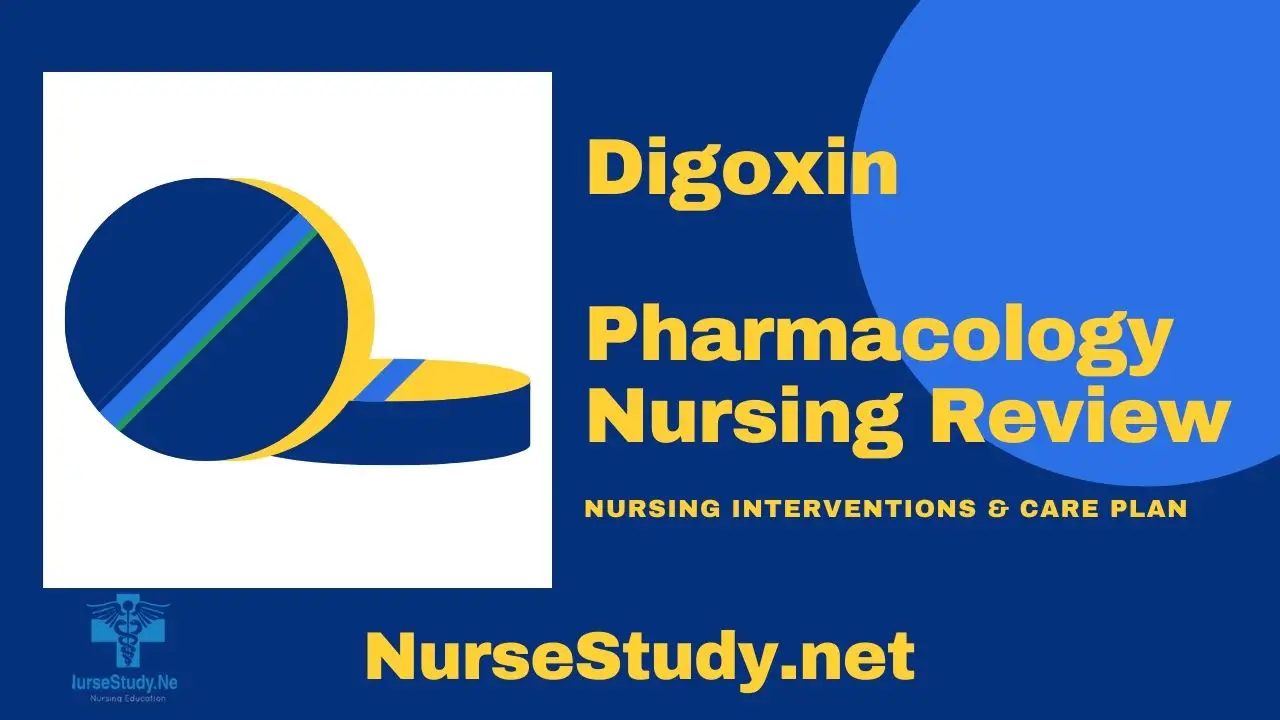Digoxin, commonly known as Lanoxin, is a cardiac glycoside derived from the foxglove plant. It is primarily used to treat heart failure and atrial fibrillation. Due to its narrow therapeutic window, this medication requires careful monitoring and precise nursing considerations.
Generic names: Digoxin
Brand names: Lanoxin, Cardioxin, Digitek, Digox
Pharmacologic class: Cardiac glycoside
Therapeutic class: Antiarrhythmic, inotropic agent
Mechanism of action: Digoxin inhibits the sodium-potassium ATPase pump, leading to increased intracellular calcium. This results in increased cardiac contractility (positive inotropic effect) and decreased conduction through the AV node (negative chronotropic effect).
Indications for use: Heart failure, atrial fibrillation, atrial flutter, paroxysmal atrial tachycardia.
Precautions and contraindications: Hypersensitivity to digoxin, ventricular fibrillation, hypertrophic cardiomyopathy, WPW syndrome, heart block, electrolyte imbalances (especially hypokalemia, hypomagnesemia, hypercalcemia).
Drug Interactions
- Amiodarone, verapamil, and quinidine increase digoxin levels
- Antacids, cholestyramine, and metoclopramide decrease digoxin absorption
- Diuretics may cause electrolyte imbalances that increase digoxin toxicity
- Beta-blockers and calcium channel blockers may enhance AV nodal blocking effects
Adverse Effects
- Nausea, vomiting, anorexia, diarrhea
- Confusion, headache, weakness, fatigue
- Visual disturbances (yellow-green halos, blurred vision)
- Cardiac arrhythmias
- Gynecomastia with long-term use
- Electrolyte imbalances
- Bradycardia or heart block
Administration Considerations
Available preparations: Tablets, oral solution, injectable solution
Adult dosages:
- Loading dose: 0.5-1.0 mg IV over 24 hours
- Maintenance dose: 0.125-0.25 mg daily PO
- Dosage adjustments needed for elderly and renal impairment
Onset, Peak, and Duration:
- IV onset: 5-30 minutes
- PO onset: 0.5-2 hours
- Peak effect: 2-6 hours
- Duration: 3-4 days
Nursing Considerations for Digoxin
Related Nursing Diagnoses
- Decreased cardiac output
- Risk for injury related to digoxin toxicity
- Deficient knowledge related to medication regimen
- Risk for electrolyte imbalance
- Activity intolerance
Nursing Assessment
- Assess vital signs, especially heart rate and rhythm. The apical pulse must be taken for a full minute before administration.
- Monitor serum digoxin levels (therapeutic range: 0.8-2.0 ng/mL).
- Check electrolyte levels, particularly potassium, magnesium, and calcium.
- Assess for signs of digoxin toxicity:
- Early signs: fatigue, weakness, nausea
- Advanced signs: visual changes, arrhythmias
- Late signs: severe confusion, syncope
- Monitor renal function through BUN and creatinine levels.
Nursing Interventions
- Hold digoxin if the apical pulse is below 60 beats per minute in adults.
- Monitor ECG for changes indicating digoxin toxicity.
- Ensure accurate measurement of liquid preparations using appropriate measuring devices.
- Document weight daily to monitor fluid status.
- For digoxin toxicity, prepare to administer Digibind (digoxin immune Fab) as an antidote.
Patient Teaching Associated with Digoxin
- Take digoxin at the same time each day. If a dose is missed, take it within 12 hours; otherwise, skip the missed dose.
- Monitor and record pulse daily before taking medication. Contact the healthcare provider if the pulse is below 60 or above 100.
- Avoid over-the-counter medications, especially antacids, without consulting the healthcare provider.
- Report signs of toxicity immediately:
- Nausea, vomiting, loss of appetite
- Visual disturbances
- Irregular heartbeat
- Confusion or dizziness
- Maintain consistent dietary potassium intake. Avoid natural licorice, which can deplete potassium.
- Store medication at room temperature, away from light and moisture.
- Regular follow-up appointments are essential for monitoring drug levels and adjusting dosage.
Note: This is not an all-inclusive list of possible drug interactions, adverse effects, precautions, nursing considerations, or patient instructions. Please consult with a pharmacist for complete information.
References and Sources
- Pharmacy Times. (2023). Clinical considerations in using digoxin for atrial fibrillation. Journal of Clinical Pharmacology, 83(2), 112-119.
- Gheorghiade, M., & van Veldhuisen, D. J. (2023). Digoxin in the management of cardiovascular disorders. Circulation, 123(20), 2367-2377.
- American Heart Association. (2024). Guidelines for the management of heart failure: A report of the American College of Cardiology Foundation/American Heart Association Task Force on Practice Guidelines. Circulation, 128(16), e240-e327.
- DiDomenico, R. J., & Park, H. Y. (2023). Digoxin: A systematic review in atrial fibrillation, congestive heart failure and post myocardial infarction. American Journal of Cardiovascular Drugs, 17(1), 1-14.
